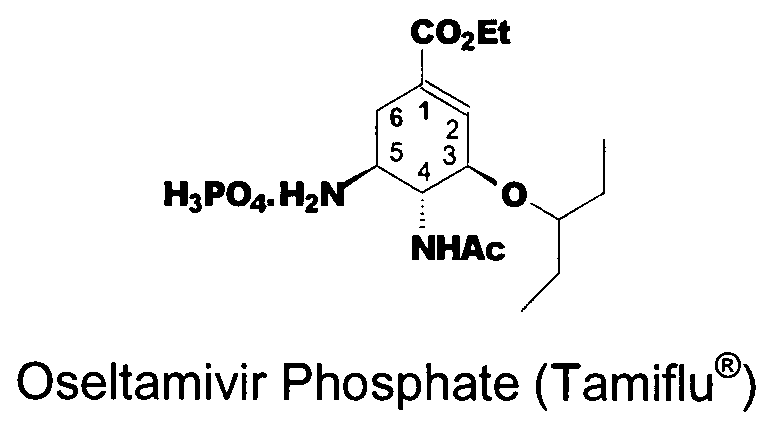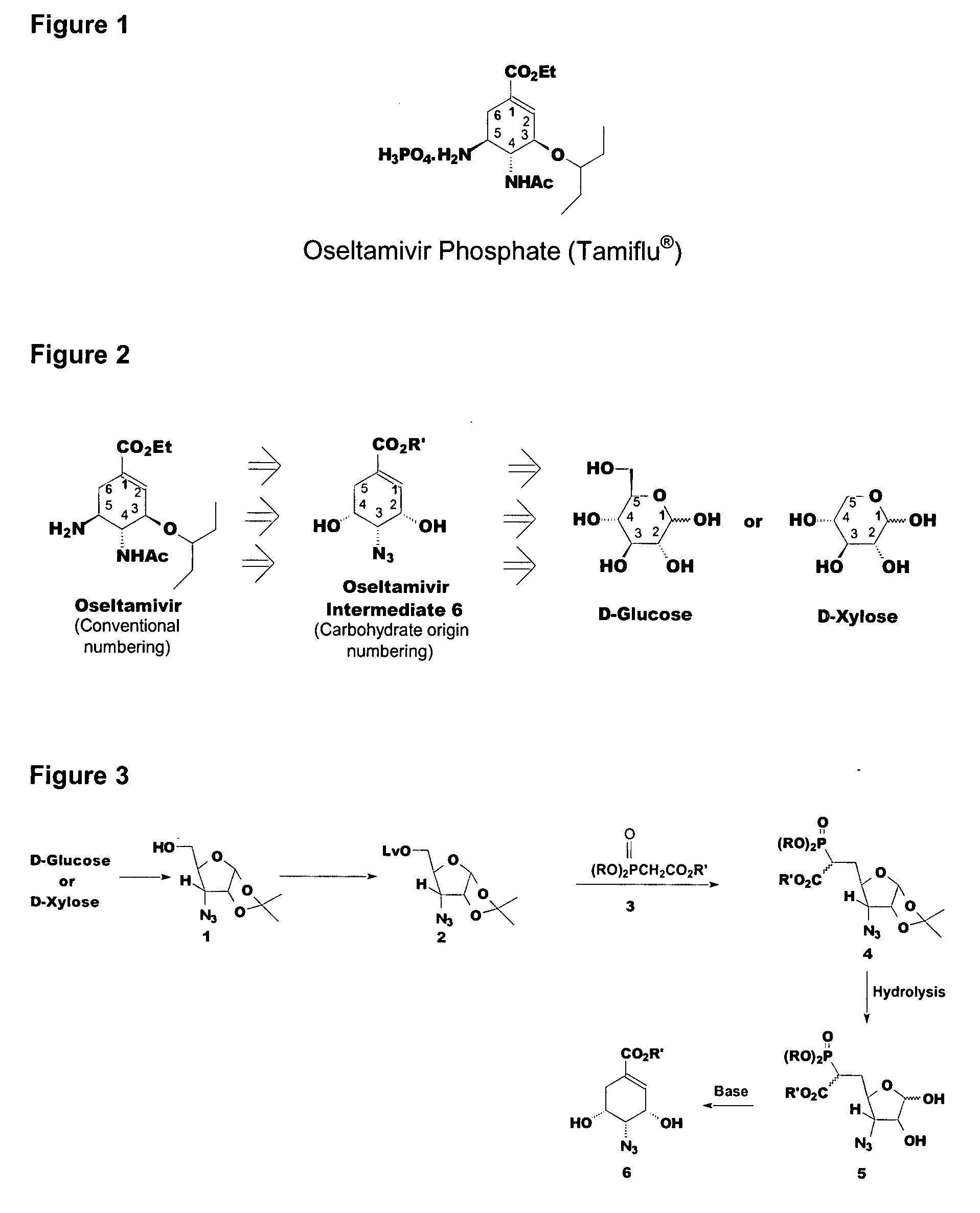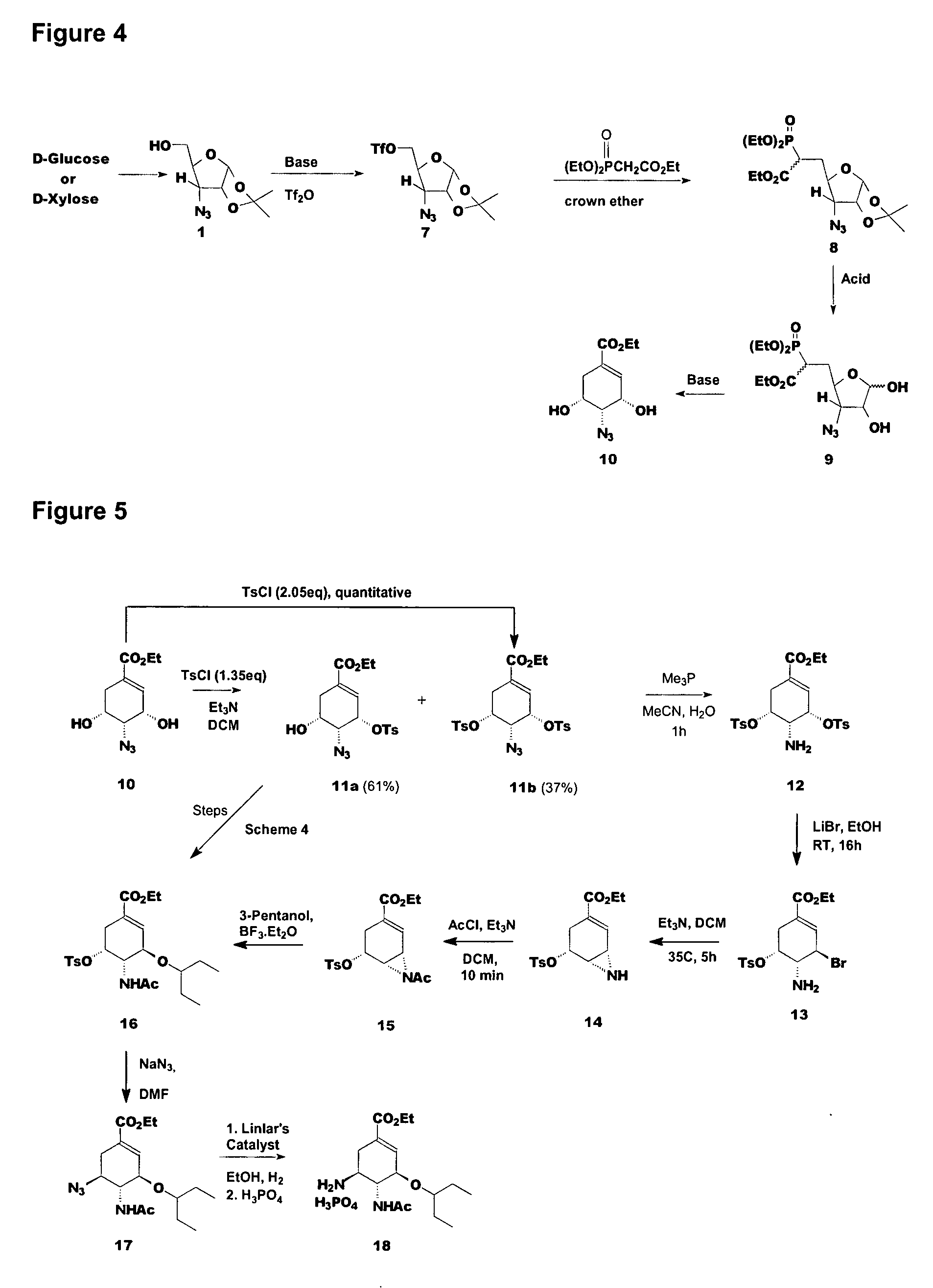Preparation of oseltamivir phosphate (Tamiflu) and intermediates starting from D-glucose or D-xylose
a technology of oseltamivir and xylose, which is applied in the preparation of sulfonic acid esters, group 5/15 element organic compounds, organic chemistry, etc., can solve the problem of marginally more expensive d-xylose than d-glucose, and achieve the effect of marginally more expensiv
- Summary
- Abstract
- Description
- Claims
- Application Information
AI Technical Summary
Benefits of technology
Problems solved by technology
Method used
Image
Examples
example 1
3-Azido-3-deoxy-1,2-di-O-isopropylidene-α-D-ribofuranoside 1
[0162]3-Azido-3-deoxy-1,2-di-O-isopropylidene-α-D-ribofuranoside (1) was prepared from glucose following procedures based on those described in R. L. Whistler et al., J. Org. Chem., (1972) 37, 3187 and P. Stazewski et al., Tetrahedron (1998) 54. To a mixture of glucose (220 g, 1099 mmol) in acetone (3.6 L) was added iodine (14.1 g, 55.4 mmol) and acetic anhydride (170 g, 1667 mmol) at room temperature. The mixture was refluxed at 59° C. for 3 h and allowed to cool whereupon triethylamine (338 g) was added slowly at ambient temperature, filtered the solid and washed twice with acetone (100 mL). The filtrate was concentrated under vacuum and water was added (600 mL). The organic layer was extracted thrice with toluene (600 mL) and the combined organic phases were concentrated. Heptane (800 mL) was added with stirring, filtered and the solid, washed with heptane-acetone (2:1, 750 mL) to obtain white crystalline solid (217 g, 7...
example 2
3-azido-3-deoxy-1,2-O-isopropylidene-5-O-trifluoromethanesulfonyl-α-D-ribofuranose 7
[0166]Compound 1 (1.16 g, 5.40 mmol) was dissolved in dichloromethane. Triethyl amine (0.8 mL, 9.8 mmol) was added and cooled to −20° C. Triflic anhydride (1.68 g, 5.94 mmol) dissolved in dichloromethane was added. The reaction was quenched with saturated aqueous sodium bicarbonate, diluted with ethyl acetate and the phases were separated. The aqueous phase was extracted with ethyl acetate and the combined organic phases were dried with anhydrous sodium sulfate, concentrated, passed through a short silica gel column using ethyl acetate / hexanes as the eluant and concentrated to give 7 as a light yellow oil (1.26 g, 3.63 mmol, 67.2%).
[0167]1H NMR (300 MHz-CDCl3) δ1.39 (s, 3H, CH3), 1.59 (s, 3H, CH3), 3.53 (dd, 1H, H-3), 4.23 (dt, 1H, H-4), 4.59 (dd, 1H, H-5a), 4.80-4.85 (m, 2H, H-2, H-5b), 5.86 (d, J1, 2=3.53, 1H, H-1), ppm.
example 3
Ethyl (3-Azido-3-deoxy-5,6-dideoxy-6R / S-diethoxyphosphoryl-1,2-O-isopropylidene-α-D-ribo-heptofuranose)uronate 8
[0168]Triethyl phosphonoacetate (3.11 g, 13.84 mmol) was added to a mixture of 60% sodium hydride (507 mg, 12.68 mmol) and 15-crown-5 (15 μL) in N,N-dimethylformamide and stirred at room temperature, for 1 hour. A solution of compound 7 (4.0 g, 11.53 mmol) in N,N-dimethylformamide was added slowly over a period of 15 minutes. After the reaction was complete, it was quenched with 1M potassium dihydrogen phosphate, diluted with ether and the phases were separated. The aqueous phase was extracted with ether and the combined organic phases were concentrated and purified using silica gel column using acetate / hexanes as the eluant to give compound 1 (880 mg, 4.13 mmol, 35.8%) and compound 8 (2.55 g, 6.06 mmol, 52.5%).
[0169]1H NMR (300 MHz-CDCl3) δ 1.27-1.37 (m, 12H, CH3, 3×CH2CH3), 1.53 (s, 3H, CH3), 2.01 (m, 0.5H, H-5Aa), 2.29 (m, 1H, H-5Ba, H-5Bb), 2.52 (m, 0.5H, H-5Ab), 3.05 ...
PUM
| Property | Measurement | Unit |
|---|---|---|
| acid | aaaaa | aaaaa |
| displacement | aaaaa | aaaaa |
| solvent | aaaaa | aaaaa |
Abstract
Description
Claims
Application Information
 Login to View More
Login to View More - R&D
- Intellectual Property
- Life Sciences
- Materials
- Tech Scout
- Unparalleled Data Quality
- Higher Quality Content
- 60% Fewer Hallucinations
Browse by: Latest US Patents, China's latest patents, Technical Efficacy Thesaurus, Application Domain, Technology Topic, Popular Technical Reports.
© 2025 PatSnap. All rights reserved.Legal|Privacy policy|Modern Slavery Act Transparency Statement|Sitemap|About US| Contact US: help@patsnap.com



